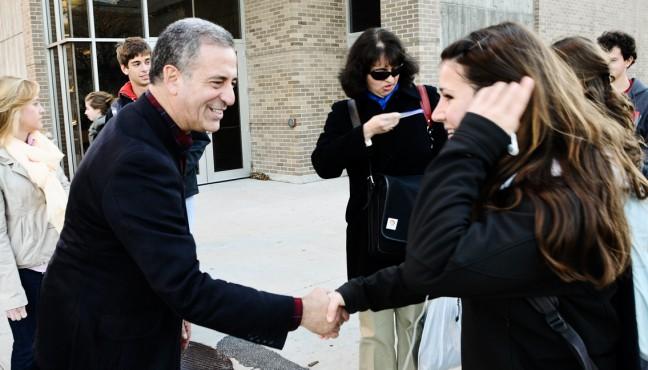From Madison to Milwaukee, voters were given one last chance Monday to meet the candidates who will appear on their election ballots today as candidates crisscrossed the state in final campaign efforts.
On the University of Wisconsin campus, incumbent Democratic Sen. Russ Feingold spent time shaking hands and meeting students in the Humanities Building and Gordon Commons.
The Feingold campaign has been on the UW campus more than any other campaign, Feingold said, a tactic he believes will make a difference at the polls tomorrow. Feingold visited Waukesha and Milwaukee as well Monday.
Republican senatorial challenger Ron Johnson also spent the day before the election visiting voters to get his message across, according to spokesperson Sarah Sendek.
Johnson went to as many places as possible to meet as many people as possible, Sendek added.
Across the state, both Republican and Democratic candidates’ final campaign schedules were markedly similar as the clock wound down to election day.
Both gubernatorial candidates followed similar schedules on the eve of the election in an effort to visit voters across the state and voice their respective messages one last time.
Republican Scott Walker, the current Milwaukee County executive, began the day in Green Bay before traveling through Eau Claire, La Crosse, Wausau and Madison, ending in Wauwatosa for a final campaign rally Monday evening.
Jill Bader, a spokesperson for Walker, said Walker’s schedule the day before the election represented a chance to get out his message on creating 250,000 jobs to as many voters as possible.
“We’re not taking a single vote for granted,” Bader said.
Democrat Tom Barrett spent his final campaign day in many of the same locations as Walker, but the Milwaukee mayor’s focus appeared to be largely on visiting labor workers.
Barrett visited a paper company in Superior and a construction company in Rhinelander before stopping in Wausau, La Crosse and Eau Claire.
Barrett’s message to voters during these stops was also focused on creating jobs, as well as reducing governmental spending, said Phil Walzak, a spokesperson for Barrett.
“The more people hear Tom Barrett’s message, the more people will support him on Tuesday,” Walzak said.
Even with pundits predicting landslide Republican victories, state GOP spokesperson Andrew Welhouse said Republicans in Wisconsin are not ready to rest on their laurels quite yet.
“No one ever won a race by stopping before the finish line, whether they were behind or ahead, so we’re going to keep campaigning until the polls close at 8:00 tomorrow evening,” Welhouse said.
State Democrats are not ready to accept any predicted fate lying down either.
The state Democratic Party has organized the biggest midterm election campaign to get out the vote in Wisconsin’s history, according to spokesperson Graeme Zielinksi.
Their efforts have resulted in more than a billion voters being contacted and encouraged to vote through the efforts of tens of thousands of volunteers, Zielinksi said.
“Democrats are good at getting out the vote, Republicans are good at writing themselves checks,” Zielinksi said.
Zielinksi said Democratic efforts to get out the vote largely involve clearing obstacles for people with children or jobs to get to the polls Tuesday.
However, these last-ditch efforts may not be enough to overcome the much-publicized “enthusiasm gap” Republicans and tea party candidates purportedly enjoy.
Democrats only stand a chance if they can succeed in rekindling the spirit of the 2008 election and ensuring high voter turnout, said Dietram Scheufele, a UW communications professor.
According to Scheufele, many election eve efforts to visit voters are not so much an attempt to change voters’ minds as to get them to show up to vote in the first place.
As far as voter turnout in Wisconsin is concerned, the Government Accountability Board is estimating approximately half the population of registered voters in the state will go to the polls Tuesday.
However, the GAB overestimated primary election turnout by 9 points, with just over 19 percent of voters turning out Sept. 14.
Final campaign efforts could also reflect a desire to make sure that number includes previously underrepresented voting demographics.
Such tactics have produced landslide victories in the past, Scheufele said.
According to Scheufele, George W. Bush’s victory in 2004 was largely due to his ability to bring 11 million voters in Ohio who had never voted before to the polls.
More recently, President Barack Obama won in 2008 based largely on his ability to bring out young voters who traditionally do not vote in high numbers, Scheufele said.
Democrats may suffer from failing to drum up the same grassroots support they enjoyed in the 2008 election, Scheufele said, which left tea party groups free to take a page out of the “Obama playbook” and turn out more voters for the midterm election.
However, when elections are close it can make a difference to make the extra effort to bring undecided voters to the polls on Election Day, especially for Democrats, Scheufele said.
“Even last minute efforts can be helpful,” Scheufele said.
Due to a reporting error, the Nov. 2 story “Candidates try to grab last-minute votes before election” stated Scott Walker plans to create 25,000. Scott Walker plans to create 250,000 jobs if elected governor. We regret the error.


